

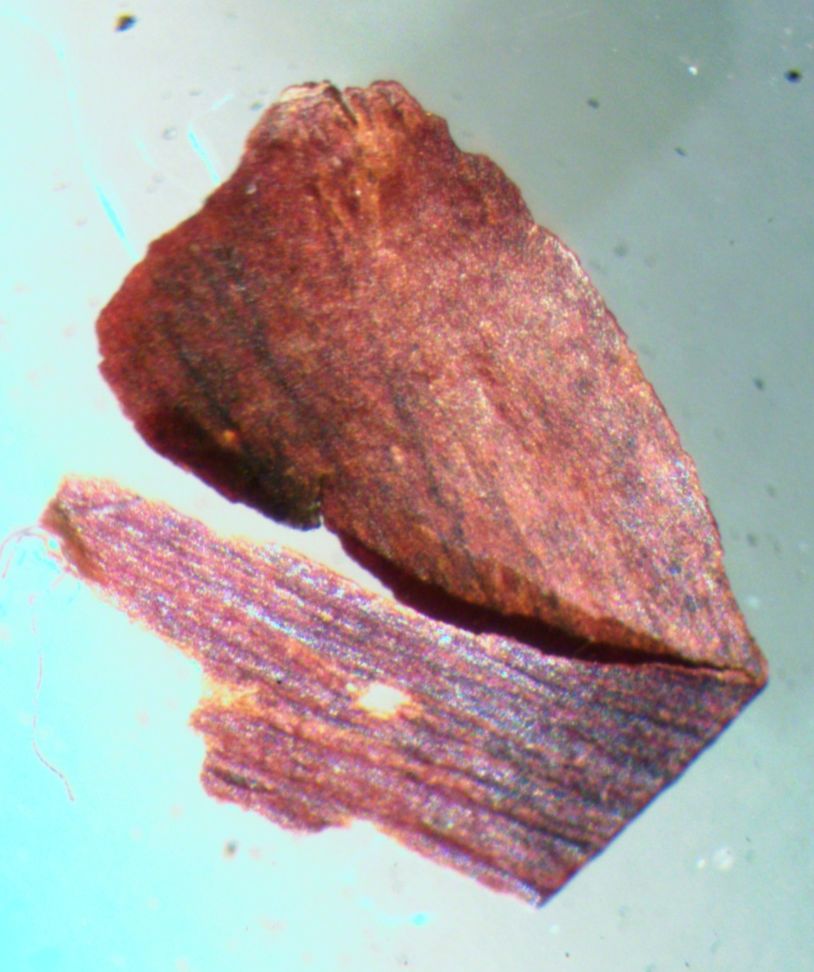
Egyptian hieroglyphs, lapis philosophorum and 'Stillhetens åndedrag'
John Bjarne Grover
In this article I discuss how apparently all the 24 fundamental egyptian hieroglyphs (normally taken to constitute a basic alphabet) from Gardiner's 'Egyptian grammar' can be derived from the philosopher's white stone - with substantial empirical support from my poetry book 'Stillhetens åndedrag' of 2016.
(Here is an introductory comment to the article).
It was in late 2009, when I moved from Venezia to Vienna, that I started writing 'Der Dornenstrauch' (henceforth 'DDS'), a work of 440 poems written in the years 2009-2015. It consists of four parts:
Part 1 = 'Kinderhilfe' of 294 poems
Part 2 = 'Unter Gesellschaft' of 64+2 = 66 poems
Part 3 = 'Linien die prägen die Sterne über uns' of 64 poems
Part 4 = 'Die Schönheit der Welt' of 16 poems.
Part 1 consists of four main parts (Hunde, Grenze, Baum, ROP) which interpret a certain cyclicity in the Rigveda of the devanagari alphabet. The poems are enumerated 'absolutely' from 1 to 294 and 'relatively' from 1 to 187, with subnumbers 107a, 107b etc. 'Grenze' starts on relative #59, which means that the cycle of 424 verses of Rigveda 1-1-1 to 1-36-3 follow the 424 poems of DDS 1-2-3 in the first column, but in the second column it starts with RV 1-1-1 on absolute #59 which is relative #47, runs it around and ends with RV 1-36-3 on absolute #58. Likewise, since 'Baum' starts on relative #114, the alignment of RV 1-1-1 with the third column starts on absolute #114 which is relative #81. And so forth for the fourth and fifth column - and when reading a poem in the book, one can compare it with the 5 verses from Rigveda in the horizontal alignment through columns 1-5. The proof for the relevance of this obtains when reading a poem and then studying the vedic verses of the four first columns in sanskrit, then putting the things aside for a break and writing down the free associations that come to your mind - and when returning from the break and looking up the verse of the fifth column in sanskrit - there are the ideas that your mind encircled in free wandering. It is about the relation between absolute and relative enumeration and a certain cyclicity in the vedic verses. If the absolute number is 58, then the relative is 47 etc. This is the counterpoint in DDS part 1 to the socalled 'reductions' of parts 2-3-4 which are characterized by just this phenomenon of 'reduction': Each part contained originally (in the first draft) more poems but the surplus (beyond 66, 64, 16) was divided into smaller parts which were appended to the first 66, 64, 16 poems. Part 2 was written as 12-liners, 3 stanzas of 4 lines each, originally some 75 poems reduced to 64 when the 11*12 = 132 lines of poems 65-75 were divided into 64 couplets appended to the first 64 - for a sort of 'shakespearean sonnets'. Some leftover material that could not be used this way was relegated to a Vorrede (poem 1) and a Nachrede (poem 66). Part 3 was written as 77,3 = nearly 78 poems of such 14-lines 'shakespearean sonnets' when eventually the poems 65-78 were divided into couplets which were interlocked with the original couplets at the end of the 14-liners for a forth 4-line stanza in the resulting 16-liners - plus titles to all the 64 poems. (Part 4 is 16 poems of 20 lines + titles, written in a similar manner). The story of how I reached the final form of part 3 is what is of interest here. It was when I came to poem 78 that there came to a total stop after some 3-4 lines: I had decided to transgress the border which had arisen at the end of part 2 and boldly go for another high peak of e.g. 365 poems or so, but some invisible wall arose in the course of poem 78 which made it impossible to continue. I struggled for days with finding a solution but had to give up and had to see whether the same solution could apply as for part 2. Indeed it did, even better this time. And the 'explanation' to this was found in poem relative #78 (= absolute #111) in DDS part 1 - a poem of 17 lines which start with 5 first lines as follows: "Leben fährt fort / eben wenn die äußere Bedingungen / die innere Erscheinungen / wiederspiegeln. Hier / sind wir plötzlich versteinert". It was when I had settled on the final form of part 3 in probably early october 2014 that I one day found what probably is a 'lapis philosophorum' in my kitchenbench. The ex nihilo matter had started to pour in after part 2 and I then bought a microscope and carried out much studies of the enigmatic matter when I found the white philosopher's stone. I mention two cases of early pieces of ex nihilo matter - the one to the left is what I call the 'philosopher of language', the two to the right are two cases of same form (an apparent christian stigma form) in two different materials - I found them with some interval of time:



The 'philosopher' is a very small piece resembling a breadcrumb - I found it in my bed one morning. The first 'stigma' occurred inside my shoe, on the inner sole, between the footsole and the shoe, and was stuck to the matter and impossible to get off, while the other occurred later at the foot end of my bed. Both 'stigma' forms were apparently made of layers of parallel strips, the first of what looked like some brass- or copper-like metal, the second a wooden strip of what resembled teak or mahogany. It clearly is a wooden 'copy' of the first - it is folded wood. Such forms of 'ex nihilo' matter started occurring after part 2 was completed. The 'philosopher' seemed to me to have theories of language - microscoping on the 'mechanics' he is talking of reveals at least two apparent moebius strips and other fine clockwork mechanics. He resembles an elephant or Ganesh type and touches his ear or hair like a realworld 'lioness woman'. It is not likely to be just an ordinary breadcrumb.
There were quite a number of such highly 'meaningful' cases of matter which seemed to be telling of the semiotics of the human mind. They could have had the function of telling in advance that the white stone I found after part 3 was completed was a real 'lapis philosophorum' and not a piece of joke which somebody had tiptoed in and left in my kitchen sink. In fact the 'philosopher' shares some important traits with the real stone. I add another two puzzling forms - the 'cake flower' which I found under my shoe (I had bought the shoe a week or so earlier and always used it when outdoors, while indoors the flat was bolted at night and it is certain that nobody else had been in there) and the archaic nail that suddenly occurred slantingly into my shoe - it looks very old but is not corroded and there were good reasons to believe that both of them had to be ex nihilo matter. The nail tickled my footsole for several days - I believed it was a small persistent pebble which cleverly hid whenever I tried to get it out - untill I searched with pliers and could pull the nail out.
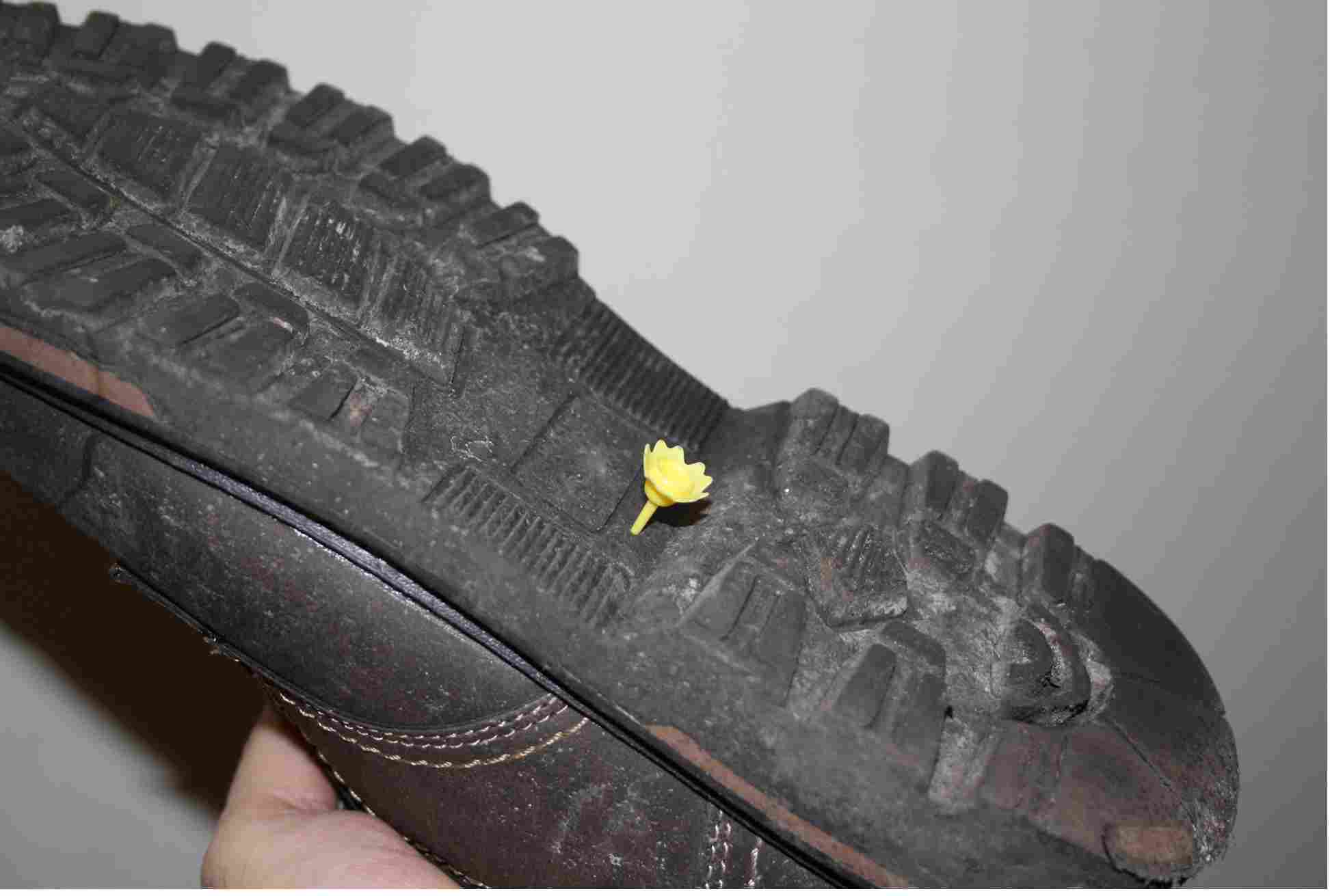
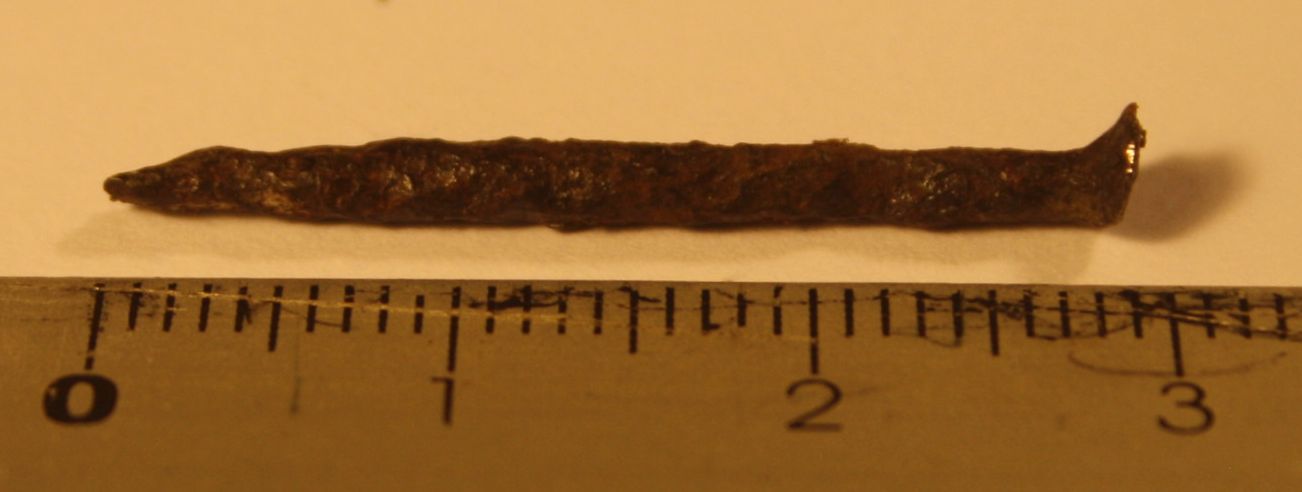
There are such indications that the stone I found in my kitchenbench in the autumn 2014 is a unique piece of 'lapis philosophorum' - I have searched in vain for documentation of this form but have so far not found any other photos or drawings of the classic stone. Mine looks like this:
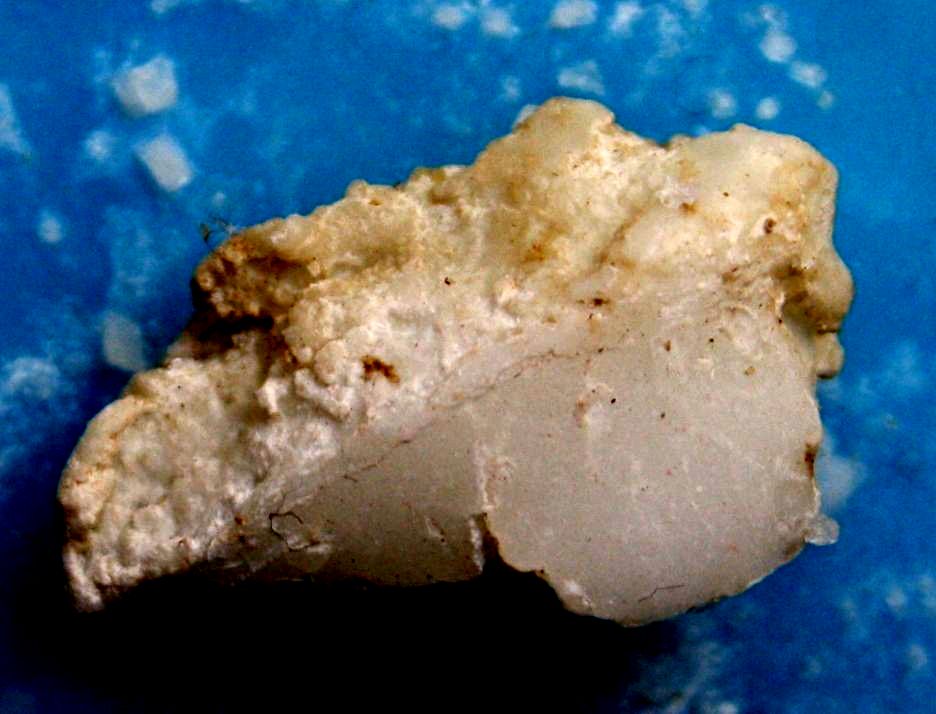
The diagonal running from low left to high right is rather exactly 2,7182 cm long - that is the exponential base constant 'e' defined as Euler's constant.

It seems that the unit of 'centimetre' could have been defined in such a way that the length of the stone is just Euler's 'e' - if, that is, the stone is always the same and always the same length. This is also a part of the reason why one could suspect that the isomorphies of hieroglyphs with the white stone (which is what I discuss below) could have been known earlier but somehow been suppressed and hidden away in the innermost sarcophagus of some secret intelligences - see the discussion of the owl below. But, on the other hand, if there is a true isomorphy, there could have been such reasons why history chose Euler to tell this constant.
I add that my physical condition in 2014 was of such a kind that it could be called a form of 'exhaustion' - from about the spring 2014 I was so totally exhausted that even the smallest form of physical work was nearly impossible for more than a few minutes. At hindsight I explain this with the white stone itself - that it is possible to find it only through a transgression of own will and concentrated efforts: The white stone comprises, as I think, the entire semiotic endowment of the human psyche and to find it one has to transcend this somehow - I believe that was the condition.
After part 4 was completed I bought a small house in Hungary and there I wrote a new work of poetry: I wanted to repeat the test of the stone to see if I could make it once again - but in a different language - and I wrote the poetry book "Stillhetens åndedrag" = "The breathing of silence" of a comparable 64 poems reduced from 105. It is written in norwegian language from 11 january 2016 to 20 september 2016 - it took appr 256 days to complete it. It is written as 105 poems with 3 stanzas of 4 lines each, except for poems 4-5-6 which had 5 stanzas each from the beginning, and after the 105 had been reduced to 64 all poems had 5 stanzas of 4 lines each plus title - that is 21 lines per poem. The white stone occurred this time as well - but now as a pumice substance resembling human bone - and it occurred before the work was completed, not after: I found it on 10 august 2016. The sensational aspect of this second stone was not that it contained the semiotic qualities of the human mind but rather that it showed patterns which seemed to be outright copies or representations of the text in the mid stanza of poem 5.
The 1344 lines of the 64 poems each of 20 lines + title line were originally 1344 lines distributed over 105 poems (only the 60 first poems had titles) - after which the poems 65-105 were dissolved and reorganized to 122 stanzas of 4 lines each (plus 4 titles to the poems 61-64) which were appended 2 and 2 to the 61 poems which had only 3 stanzas - and the result was 64 poems with 1344 lines. In the construction of the 122 stanzas, the lines were interlocked for the ABAB rhymes - uneven lines 1-3-5... from poem 65 were interlocked with the even lines 2-4-6... from poem 65+31 = 96 (the interval of 31 poems was due to a natural border at 34 poems minus the 3 poems #4-5-6) untill 105-31 = poem #74 had been reached - and there from uneven lines of #74 interlocking with even lines of #105 there follows a wrapover from 105 to 65 which means that the uneven lines of #75 interlock with the even lines of #65 (where it had started with the uneven lines) and #76 and #66 untill all lines were emptied into 122 stanzas of 4 lines each. These were appeded to the 64-3 = 61 poems pairwise starting from the end #64 down to #1 - with the order of the pairs A-B in natural order down to #33 and then in reverse order B-A for the poems 32-1.
The philosophical principle is that the 105 poems were written by way of faith - the poet wrote a poem and there came an answer from history or eternity a day or two later - which the poet grasped and moulded into a new poem - and so forth in interaction with the 'divine' or 'history' or what one wants to call it - untill 105 poems were reached. The theory is that the 105 poems are 'faith' and the 64 reduced poems are 'knowledge' - and it is the relation between these which is an interesting study which contributes to a form of knowledge of the form of knowledge. It is a relevant study because one can prove that the resulting 64 poems are very relevant to a series of prominent or essential phenomena. The method of reduction was more complex than for DDS part 3 and I naturally had to ask myself whether the resulting structure was poetically relevant or if it were just a coincidental scramble. I found several good indications that it was essential and not coincidental - such as egyptian hieroglyphs and the early chinese I Ching, the work of Vermeer, a string quartet of Luigi Nono - as well as what I call the fundamental theorem of linguistics: In the years 1997-2008 I had written a 16-volume work of poetry (there are 1719 enumerated poems in the work) called The Endmorgan Quartet: When I by simple word processing extracted the words that occurred twice and only twice in each of the four volumes 13-16, it turned out to be exactly 1345 such word pairs - and when I aligned these against the 64 * 21 = 1344 lines of my new book in norwegian language, it turned out that the 1345 twice-occurring words when listed in alphabetic order receive quite interesting definitions from the 1344 lines of my book (the 1345th was the single norwegian letter 'å'). The corollary was that semantic assignment and logical order were one and the same thing - and this served as a proof that the resulting 1344 lines had a form and order which was far from coincidental. It adds to this story that book 1 in the same work (TEQ) has 320 words which occur twice and only twice, same number as lines (not including titles) in DDS part 4.
However, an equally interesting reason for assuming that the 1344 lines of the completed 64 poems had a necessary and non-coincidental order and form was in the correlation (which I discuss in this article) with the list of the 24 most fundamental egyptian hieroglyphs listed in Gardiner's "Egyptian grammar" (third edition, reprinted 2012) page 27. (See the list of uniconsonantals in this file). Starting on line 10 in the first poem and observing the relevance of this for the 10th sign in Gardiner's list, the wavy water line 'n', it turns out that the rest of the signs in the list (11-24 followed by 1-9) found interesting interpretations in every 56th line throughout the book (56 * 24 = 1344) - in the order of occurrence in Gardiner's book in such a way that the lines can be used to find the hieroglyphic signs represented in the lapis philosophorum that occurred at the end of the work with DDS part 3. This is the contents of this article.
I here go through the list of egyptian hieroglyphs relative to the poetic lines of my book 'Stillhetens åndedrag' and the relevant fragments from the stone. Here are the 24 hieroglyphic signs in Gardiner's list aligned with the relevant lines from my book, with translation and indication of poem and line numbers. The glyphs are listed in the order of occurrence of the corresponding line in my poetry book (leftmost column), while the number of occurrence in Gardiner's list is given at the name of the glyphs - the poetic lines to the right with translations in italics:
|
Poem & line 1, 10 4,3 6,17 9,10 12,3 14,17 17,10 20,3 22,17 25,10 28,3 30,17 33,10 36,3 38,17 41,10 44,3 46,17 49,10 52,3 54,17 57,10 60,3 62,17 |
Fon n r h H x c s S q k g t T d D ? j y Q w b p f m |
Glyph 10. water 11. mouth 12. reed shelter in fields 13. wick of twisted flax 14. placenta 15. animal belly with teats 16. bolt, folded cloth 17. pool 18. hill-slope 19. basket with handle 20. stand for jar 21. loaf 22. tethering roper 23. hand 24. snake 1. egyptian vulture 2. flowering reed 3. 2 reed flowers, 2 obl strokes \\ 4. forearm 5. quail chick 6. foot 7. stool 8. horned viper 9. owl |
Line Jeg elsker en kvinne på jorden I love a woman on the earth som legemet mener er sant which the body means is true Jeg trodde hun hadde rett. I believed that she was right Du sier du gjerne vil elske You say you would like to love jeg kunne se I could see hører en kosmisk musikk. hears a cosmic music som hadde sitt utspring i tiden which had their origin in the time som over vannet går that over the water goes at stenen var åndens tak. that the stone was the spirit's ceiling/roof Der hvor veienes rundhet svinger There where the roads' roundness turn synger hun sin sang: she sings her song når nymånen engang blir full: when the new moon once becomes full Tror du at tingene finnes i verden Do you believe that the things exist in the world Vi kan ikke tenke oss noe mer We cannot think of anything more kaster tilbake der over, throws back thereover Det var med midtskrav og glosebok It was with midhatch and glossary om mursteinsdøren er en lav en if the brickstone door is a low one som flom, litus og blomst, like flooding, litus and flower Men setter HELT og får betalt for det. One calls it HERO and gets paid for it som fuglenes stil like the birds' style Mannen med hvit stokk går. The man with a white stick walks kunnskap som et gammelt vers. knowledge like an old verse når veien er dunkel, when the road is dark sitt innerste bryst its innermost breast |
Now the interesting observation is that all the most central egyptian hieroglyphic signs seem to be present in the symbolism of the white stone - the 'lapis philosophorum' which I made in 2014.
The face of the stone, shown in the photo above, seems to tell of the head of a sleeping eagle or lamb (cp. Christ) to the left and a male face to the right. It seems that the diagonal dividing them is the rope with which the boy pulls the archetypal 'man-on-wagon' across the street - and then the boy is likely to be just that male face to the right. Under the sleeping lamb's eye there are the outlines of a naked woman - her naked breasts are easily understood as female but her right hand is ambiguous: Either it shows her pointing down towards her own female genitals or she is clutching a male phallus rising up from the fork, in which case one could talk of a man with female breasts. It is probably essential that one cannot find out which is the real one. On the leftmost beak tip of the sleeping 'eagle' there are the outlines of what looks like the behind of a naked man who is just climbing up - one sees his folded knee. This can be recognized in Caravaggio's 1601 Emmaus artwork - the leftmost character is the man with the elbows while Christ is the naked male/female in the mid. It is of course possible that Caravaggio had access to a real 'lapis philosophorum' of the type I found - unless his Emmaus works are just normal aspects of the human psyche and semiotic constitution. (I have made a study of his works which shows that each and every of them has a HIGH and a LOW aspect which correlate with the cyclicity of the 64 poems of DDS part 3 in a way which can be seen as contained in the yellow plastic cake decoration flower that I found under my shoe: The HIGH cycle goes in steps of 1 or 2, the LOW in steps of 5). Jacob Boehme talks of the white philosopher's stone as the same as Jesus Christ himself - and indeed western history of the recent millenium (1000-2000) can be seen as an elaboration of the similarity and difference between the rigvedic SOMA stone and the christian bread of the holy communion.
The stone resembles also a human brain. The socalled 'cognitive revolution' since the 1950's could have had some rootings in the role of the white philosopher's stone as the essence of human semiotics, including language.
My technical facilities have been rather simple but they will hopefully suffice for giving an idea of the correlations in the following discussion. As the first example clearly shows, it seems that it is the role of principled and unsolvable ambiguities which is the defining force in the relation of the hieroglyphs with the white stone. But that is just what language seems to be as well.
I discuss the 24 glyphs relative to the stone and my own poetic lines from 'Stillheten' and start with the glyph which is last in my book:
9. The owl
The most suggestive one is perhaps the owl of Gardiner's list #9 (the following glyph signs are quotes from the list on p.27 in Gardiner's book) - it can be found at the heart of the ambiguity of gender for the mid character of the white stone:



The ambiguity is that one cannot decide whether the excerpt from the stone shows a man's palm clutching his own erection or the uppermost part of that erection rather is the index finger of a woman pointing down towards her own hymen. One adjusts the lens of the microscope and the light from the lamp for enhancing the shadows maximally - but is somehow always left with an unsolvable dilemma of gender. The innermost ambiguity seems to be precisely there - in the pointing or clutching hand which is at the place of the breast of the owl - and that is 'its innermost breast' = 'sitt innerste bryst' of my poem 62 line 17. This is the glyph defined last in my book. Notice that it is the right hand of the subject of the mid character on the stone which points or clutches - while the left hand - the left wing of the owl - seems to be pointing in between the two human breasts above this point of ambiguity - that is, it is pointing towards 'its innermost breast' = 'sitt innerste bryst'. This left/right is perhaps the secret of human semiotics and limited/redundant reality which distinguishes it e.g. from the reality of birds: The right hand writes with the left hemisphere of the human brain.
5. Quail chick
As far as the egyptian vulture and the quail chick are concerned, these share important traits with the owl - and one can think of these as variants of the owl by way of small differences of the same 'ambiguous' kind as the human genders of the owl: For the vulture and quail chick the attention is lifted one level up - for identifying the head of the bird in or just above one of the two breasts - and not in the hand below as for the owl:

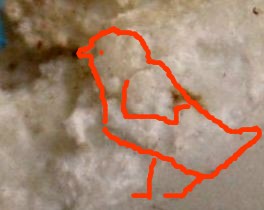

The head of the bird is clearly visible at the shoulder of the human form. The poetic line goes: 'Som fuglenes stil' = 'like the birds' style'. It seems that the bird head is somehow sucking on the line of the eye - but birds are not mammals, they are born from laid eggs. There is a simple proof why bird reality is something different from human reality - that is in the reports that birds have been flying thousands of kilometres without landing, and simple physical computation can probably tell that this is not theoretically possible unless birds have another energy source than humans can detect. The quail chick could perhaps be telling: They get their nourishment from the light of the sleeping eye - that is, from an inner reality of dreams. And when the sleeping eye of the eagle or lamb seems to have erotic dreams, that tells of a similar 'inner source' of energy and life. See 'forearm' below.
1. Egyptian vulture
The egyptian vulture would be the same part as the quail - only that the longer beak of the bird extends into the eye of the sleeping 'eagle' or 'lamb'. The difference between the assumed labial 'w' of the quail chick and the assumed glottal stop of the vulture is that the 'transcendent' eye is included in the bird.
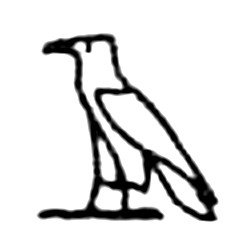


Notice that even the eye of the bird can be seen in the detail of the stone - the small dot in the corner of the eagle's eye.
The difference between owl and quail/vulture is then in LOW vs HIGH - such as for phonological features. Between quail and vulture there could be a FRONT vs. BACK.
'Stillheten' corresponding line for the vulture: 'Det var med midtskrav og glosebok' = 'it was with midhatch and glossary book'. For the 'midskrav' see below on the placenta, for the 'glosebok' see the 'pool' - both of which seem to apply to the eye. 'Skrav' is really 'skravering' if it is supposed to mean 'hatched lines'. It is interesting indeed that the hatching applies also to the style of birds!
14. The placenta
This is inside the human foetus womb and correlates to the inside the bird egg during the hatching. The reason for understanding this placenta form in the bird's or sleeper's eye is in the wellknown child abuse form of couping a child's future by opening the soft newborn skull a few days after birth and masturbating a clot of sperm onto its cortex and closing it again. The coup is a perverted form of Matth.3,17 (Jesus stepping out of the water of baptism) in the form of the voice and dove telling 'this is my son whom I love - with him I am well pleased' - perverted into the form of the masturbator saying 'this is my erection', being next to but not the same as the child, thereby taking the place of the placenta in the human womb. The decisive proof for the child of this abuse is the difference between outside and inside the womb - the difference between humans and birds - and that means whether the child could see anything when it happened - whether the eyes were open or not (cp. the closed eyes of newborn cats). The line 3 of poem 12 is 'jeg kunne se' = 'I could see' - and that is the reason for recognizing the 'placenta' with the otherwise odd glyph-form it has:
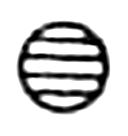
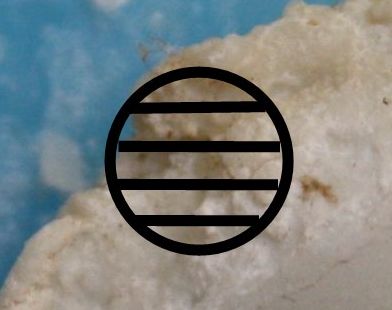

Likewise, the hatched form corresponds to the poetic line of the vulture.
17. Pool
The pool symbol is probably seen from above - the outlines of a swimming or water pool. The poetic line is 'som over vannet går' = 'that over the water goes'. What goes over the water? According to the very beginning of the Bible, it was darkness and the spirit of God that was over the first water - before God's word was pronounced for creating the light. This tells of the 'darkness' of the sleeping eye.
The glyph of the 'pool' is likely to be either the stripe of the eye or the eyebrow above it - both of which are over the water that goes on the ambiguous masturbator. Why should it be a 'glosebok' = 'glossary book'? Because that is a pool of words.


The logic applies also to one horizontal part of the hatched circle form of the 'placenta'. I refer to this file - the white brick at the foot of the cat - for the form of the glyph 'pool' - see the parallel with the water-containing 'amphora' or human organ symbolized in the parallel 'revelation'. The same file contains also the Ganesh-like 'philosopher' in the top of the gate where the bricks leapt out - and the passport photo stamped by 'Mies-Mies'. Is it Jessenin's foot with wellington? The white brick at the foot of the cat can also be recognized in the story of the monte - the illustration of the 'indian' turned to the mumin with the white cat under the arm - and then the 'pool' will be the same as the chinese GUAI sign = #43 in the I Ching. Could be that would associate with the hieroglyphic 'hill-slope' sign? If so, the 'pool' could also simply be the slanting groove between the two hilltops on the stone. But this is slanting and not straight - and if the GUAI sign resembles a glyphic placenta, then there is the eye of the 'eagle' left for the 'pool'.
4. Forearm
The poetic line is 'man setter HELT og får betalt for det' = 'one sets HERO and gets paid for it'. The underarm has two bones while the upper arm has only one, while the blue metre has 1 millenium time span and the red has 2 seconds (TEQ book 16). But the blue is the collective consciousness which the underarm is working with, and the red is the subjective consciousness which the upper arm is closer to - hence there is a paradox of 1 and 2 which is what WORK is concerned with when the subject is paid for contributing to a change in the state of the collective historic consciousness. That means that the subject is a hero - but since one is paid for the work, it is a possible role. This is the forearm. It could mean the black stripe of the eye. See the hand.
'Man setter HELT og får betalt for det' can also mean that one sets POURED and gets BED-ALTITUDE for it - that is a creek with some elevated sandbanks in a wooden environment. This is when the subjective and collective consciousness replace each other in a way which obtains to VISION - and hence the forearm resembles the eye.
The ambiguity of work / vision is contained in the similarity of the horizontal stripe of the eye on the stone with the horizontal stripe of the underarm.
But the obvious underarm is the one on the masturbator - notably the one pointing towards 'its innermost breast'. If the unit of the subjective consciousness is 2 seconds, it really means two heartbeats.
Hence the ambiguity is essentially the one between subjective (heart) and collective consciousness.



10. Water
At the foot of the mid character, under the phallus or pointing index, there is - right under the big diagonal line - a pattern which looks like a zigzag line. It must be photographically enhanced for contrast for being easily visible. The poetic line is 'jeg elsker en kvinne på jorden' = 'I love a woman on the earth' - which could be telling of the water falling down from the phallus.
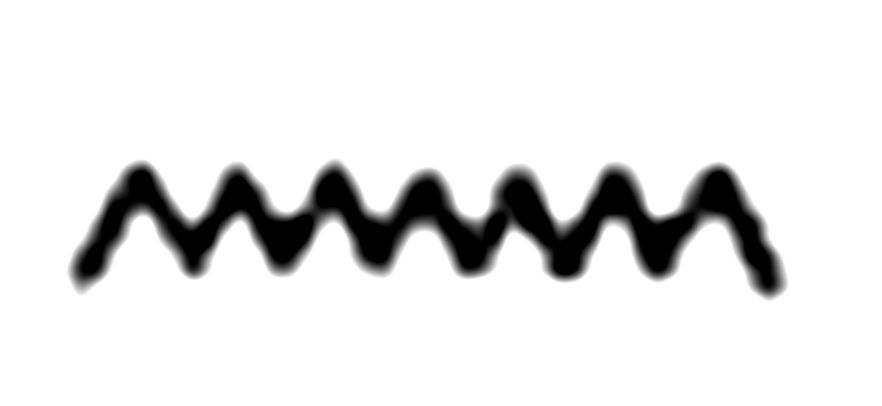


7. Stool
Likewise, slightly above the zigzag water line, could be a little to the right, there is rather precisely on the diagonal a colon sign followed by a slanting box resembling the 'stool' glyph pushed into a parallelogram:



The poetic line line is 'kunnskap som et gammelt vers' = 'knowledge like an old verse' - it tells of the reduction principle from 105 = faith to 64 = knowledge and even resembles the tethering rope somewhat. A closer look at the pattern tells that the righthand side is only halfway there - could be reshaped by the colon sign to the left.
6. Foot
The foot is akin to the stool - in the sense of showing the same colon sign but turned 90 degrees and on the footblade - the colon of the stool is where the ankle leads up to the leg which extends down from the mid character:



Poetic line: 'Mannen med hvit stokk går' = 'the man with white stick goes/walks'. The 'white stick' can possibly be the phallus of the man. The dot underneath the footblade is like that nail I got in the shoe - and the yellow flower.
20. The stand for jar
The G is a socalled 'stand for jar' - in my poem it is 'synger hun sin sang' = 'she sings her song'. That should expectedly be in the fork of the woman - and that seems to be the case - here the sign and the detail of the fork of the woman annotated:
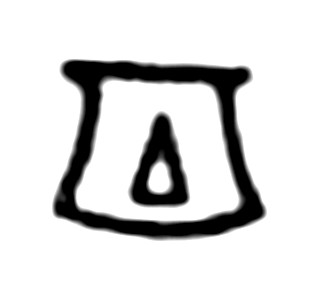


15. Animal's belly with teats
The palatal fricative 'c' is called 'animal's belly with teats' and in my poem 14 line 17 it is called 'hører en kosmisk musikk' = 'hears a cosmic music'. That should expectedly be in the ear region of the sleeping eagle - that should be the speck of 'dirt' behind the female breast - the 'cosmic' source of the 'music':
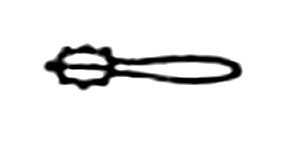


There can perhaps be remnants of the rugged line around the breast of the glyph, but this is more notable in the 'speck' - hence one could think of it as inherently 'rotated'. This is supported by the idea of the Wernicke-Broca division line as applying to the difference between the speaker's mouth and the listener's ear - and on the stone the mouth of the 'other man' (to the right) is a speck of colour resembling the ear of the eagle:

The reason for this rotation principle would be in the Wernicke-Broca ambiguity of audition and acoustics - the need for bridging that gap by way of rotatory symmetries which makes the one side the same as the other. This is the counterpoint to the ambiguity of gender in the hand and phallus.
8. Horned viper
If the stone is turned 30 degrees, the resulting underarm of the naked character can be seen as the horned viper with the breast giving lines to the horns:
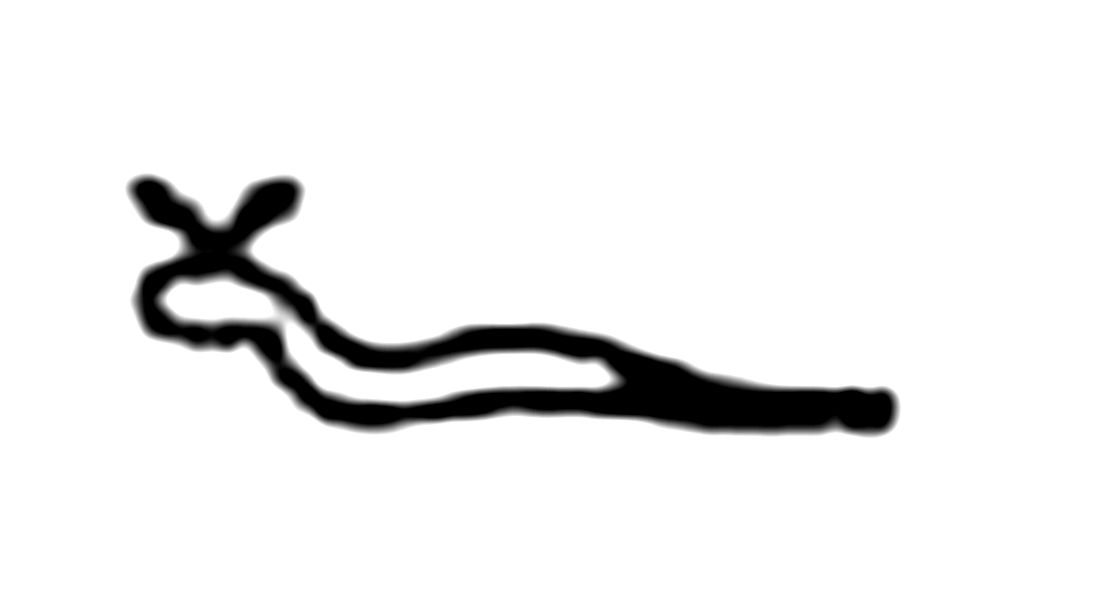

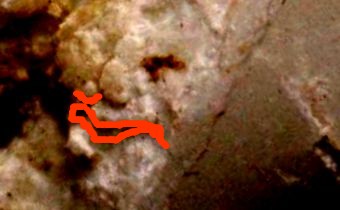
There is also a big version of this if the whole stone is mirrored and then turned 30 degrees - this will be turning the same rotatory direction but the opposite way since the stone is mirrored:

The poetic line is 'når veien er dunkel' = 'when the road is dark' - then you have to fumble yourself forwards with the hands serving as orientation organs - the two 'horns' of the hands being sensory antenna in mirrored forms (left mirrors right on the body) and somewhat turned to perhaps 30 degrees. The one is much bigger than the other - which could be telling of the lateralization of the human body. Notice also that the big bump on the top of the mirrored stone equals the one breast of the naked character - and then the eye of the mirrored eagle corresponds to the ear speck just beside the breast of the non-mirrored.
12. Reed shelter in fields
The labyrinthic pattern of this glyph can be recognized from the area of the climbing man on the tip of the beak of the eagle - it is the same as the elbows of the leftmost man in Caravaggio's 1601 'Emmaus' artwork:
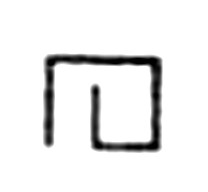



Did they have reed-wall conveniences or latrines in the fields even in those days? The leftmost character on the stone looks like a man who is climbing up into the bed of the naked woman - my poetic line tells "jeg trodde hun hadde rett" = 'I believed that she was/'had' right'. The ambiguity of the sign is one of grammatical aspect - whether it shows a fenced-in latrine where humans could excrete unobserved or if it is the excreter himself.
There is an interesting correlation with the graphic cover illustration to the book 'Stillhetens åndedrag' - when this illustration is turned 90 degrees to show the dauhter who has lost a milky tooth and the mother inspecting it - then the tip of the beak of the white stone eagle resembles the tip of a violin with its curving snailhouse embellishment - which in the glyph is 'right':
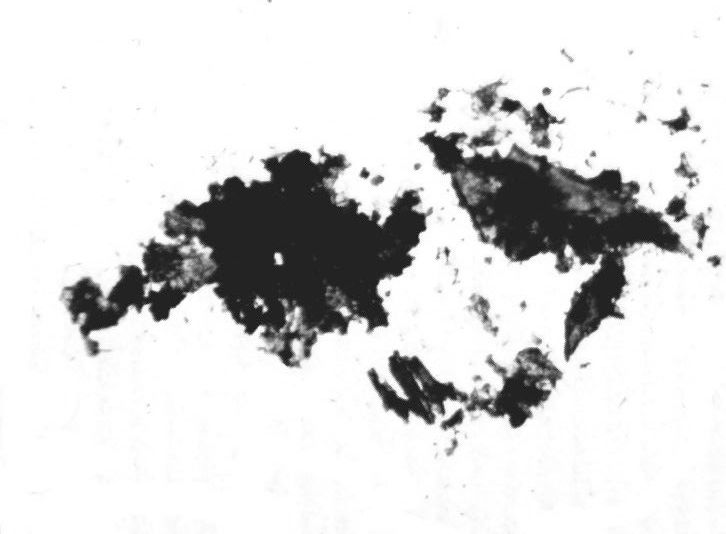


13. Wick of twisted flax
This could be seen at the tip of the snout of the eagle - cp.also the inside/outside ASPECT of the reed shelter in fields:


The poetic line is 'du sier du gjerne vil elske' = 'you say that you want to [make] love'. What is the ambiguity? It could be that the wick to the left is in the extremity of the stone while the wick to the right is in the extremities of the depicted character.
24. Snake
has the line "kaster tilbake der over" = 'throws back there over' which could apply to the boy who pulls the man-on-wagon - he attracts your attention in the corner of your eye with a lifted finger. This could therefore be the relevant form of the eye of the man to the right:



2. Flowering reed
The flowering reed exists in two versions - one single reed and one double. The double exists also as two slanting strokes or diagonals. Clearly the diagonal is an essential part of this symbol: Here the photo is first tilted 60 degrees for obtaining a vertical line out of the diagonal - and next it is tilted to 90 degrees counterclockwise for obtaining the rectangular form which lends meaning to the straight line on the lefthand side of the reed symbol:
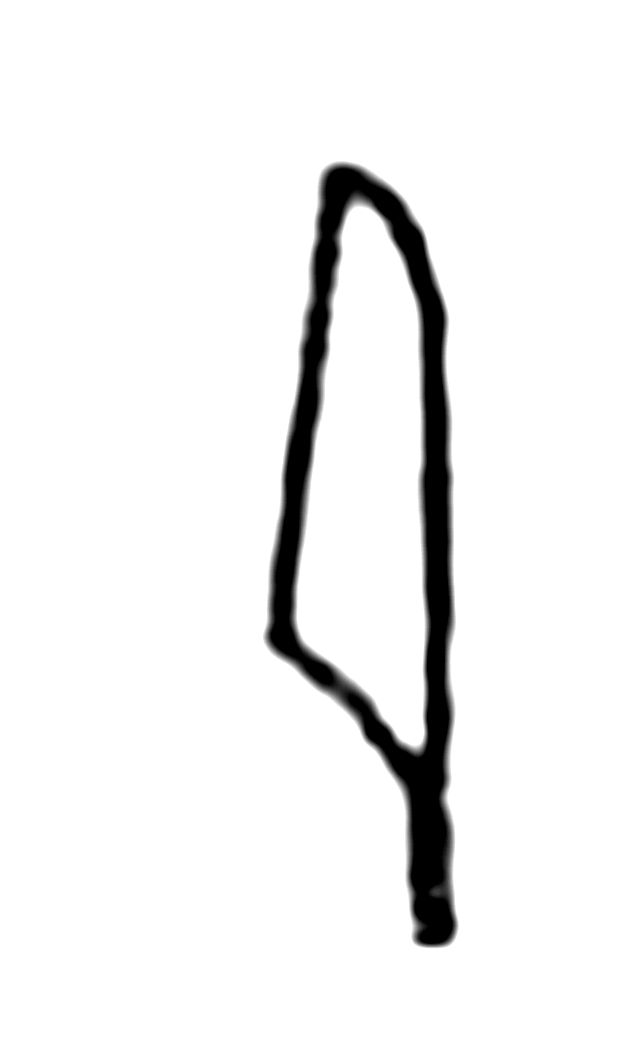
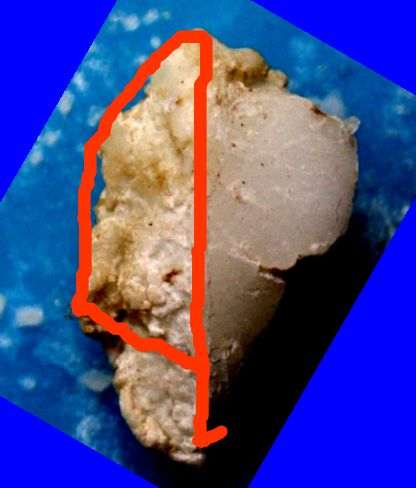

This is also when the poetic line of mine makes sense: 'om mursteinsdören er en lav en' = 'if the brick stone door is a low one'. The hinges of this door could be on the righthand side, where there is the indentation on the mid, or on the left side corresponding to the straight line of the reed symbol - in which case the indentation looks somewhat like a door handle.
3. Reed flowers
This is two of the previous glyph - or two slanting diagonals - lending meaning to the 'door' with the diagonal from corner to corner. The poetic line of mine is 'som flom, litus og blomst' = 'like flooding, litus and flower'. 'Litus' is latin for 1) 'smear-over', 'paint', 2) strand, coast, beach. ('Lituus' = a shepherd's curved stick). This seems to tell of the shoesole phenomenon - the nail of archaic type and the yellow plastic flower of cake decoration type up into the shoesole in the lifted part between the front blade and the heel. The flower occurred before I found the first stone, the nail was just after 'Stillheten' was completed, that is after the second white stone. In either case this seems to tell of tilting, turning, degrees of observation of the stone. The diagonal strokes of this glyph would be telling of the slanting nail while the two flowers would be telling of the plastic cake decoration flower under the shoe. I notice the 'voice'-gap in the lower part of the stone - the apparent door handle if the door be hinged on the lefthand side - it could mean the lifted part between front footblade and heel on a shoe.

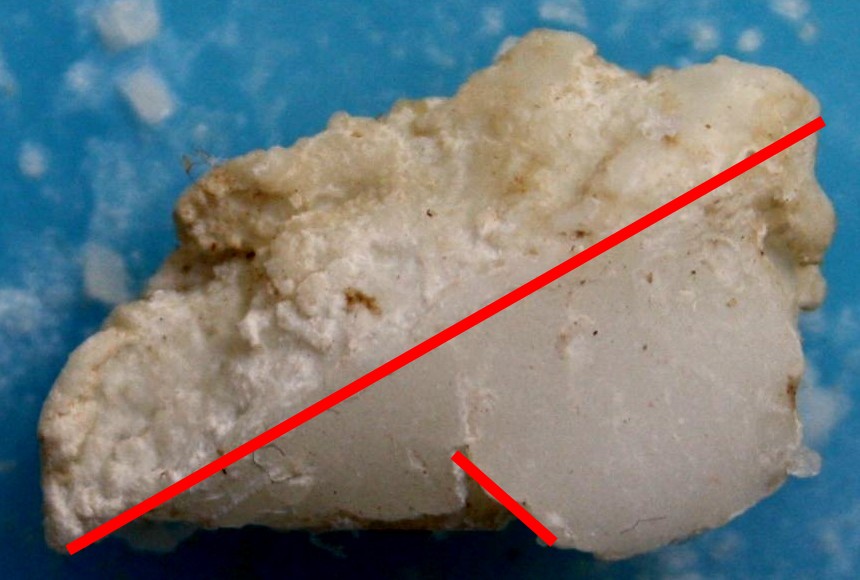
The big diagonal is e = 2,7182818... cm long - and it is likely that the centimetre even has been defined on basis of just this diagonal. My guess is that it is old wisdom that the diagonal is 2 but not 3 units long. But it must be noticed that the centimetre is likely to have been defined after the stone and not the other way round - so there would be nothing magic about the 'e' of this diagonal.
22. Tethering rope
This seems to be formed as the reduction from 105 to 64 and with that the reduction from faith to knowledge. There are two 'forks' of faith - one big and one small - both with 'open loops' - and these reduce to the knowledge tether-rope of a U-shape with loops at the end:



The line from poem 33 line 10 is 'tror du at tingene finnes i verden' = 'do you believe that the things exist in the world' - that is, the relation between faith and knowledge.
16. Bolt, folded cloth
The story is the horned beetle which I myself experienced ex nihilo: I was sitting at my desk which is covered with a black rubber mat with measures of a vertical and horizontal centimetre grid - when suddenly a horned beetle took form ex nihilo on the point 75 horizontally 25 vertically. It waved its tail and folded the one of its two antennae on the mid - and then it died.

The poetic line for this symbol is 'som hadde sitt utspring i tiden' = 'which had its origin in time', telling of just this: It crosses the border line to existence and then soon thereafter dies. As far as I can see, the relevant part of the white stone which corresponds to this glyph is the mark behind the eye of the sleeper, just before the slope:




A closer look at the horizontal line tells that there probably is a thicker part there in the mid where the vertical crosses it. The shepherd stick could be related as 'lituus' to the above 'litus'.
11. Mouth
The reason for this interpretation is the poetic line 'som legemet mener er sant' = 'what the body means is true' which is pronounced from the mouth with voice and that seems to be the mark at the bottom. In addition, 'true' = 'sant' which resembles 'sandet' = 'the sand' that runs through an hourglass and takes on a form at the bottom a la that indentation, dividing the lapis in two halves. It will be the curved form of the cheek of the righthand face which is the reason for the curved lips - which extend from the 'corner of the mouth' at the bottom to the corner of the mouth to the right.
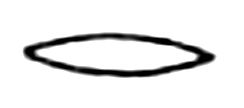

23. Hand
The hand is the correlate in the left side to the mouth in the right - it is a transcendent organ - and the christian stigma looks into eternity, so to speak. The poetic line is 'vi kan ikke tenke oss noe mer' = 'we cannot think ourselves / fancy / imagine anything more' - which tells of the limits to human imagination. This is why the hand symbol extends imaginatively beyond the limits to the material stone itself - it extends into the field of vision in front of it.
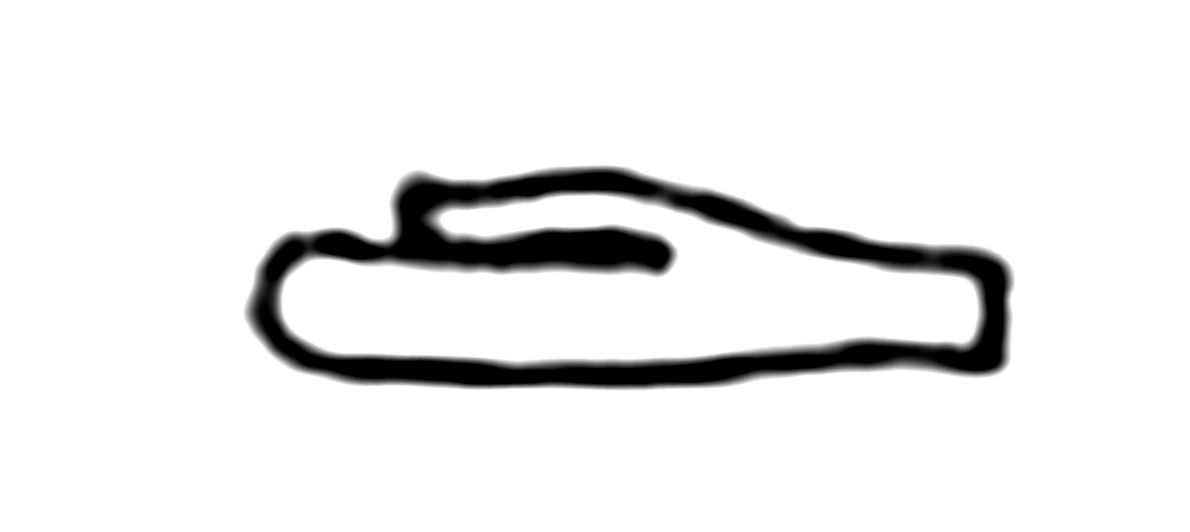


The 'transcendence' is obtained from the field of vision outside the eye to the tilted 'brain' with the occipital lobe turned into the frontal lobe - and then the hand is magnified to comprise a good part of the total stone:

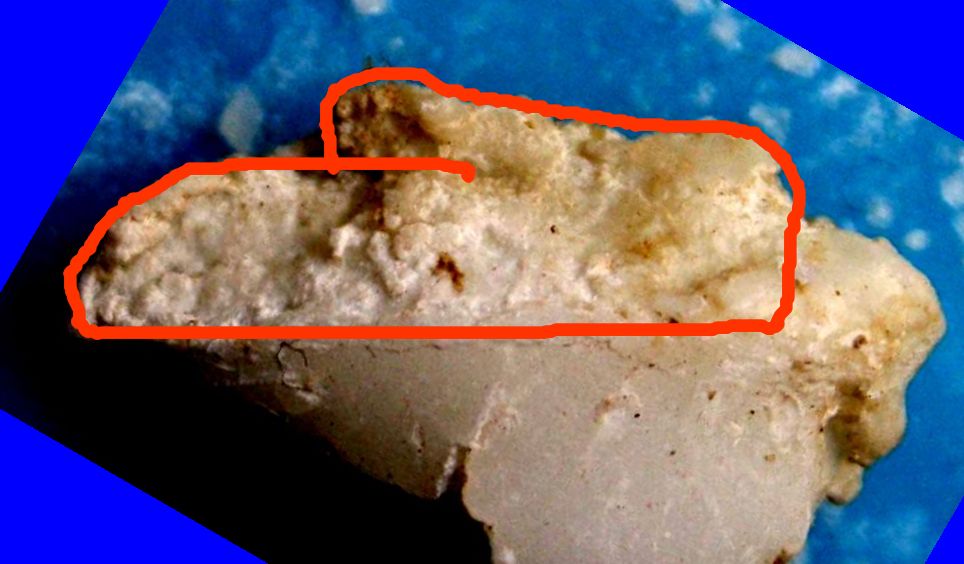

Clearly for the smaller hand, a stigma will find its position in the eye - hence the vulture - while for the bigger hand the same stigma will be in the masturbator - hence owl. Cp. the two stigmas I had found before I found the stone itself.
18. The hill-slope
Notice also the similar structure at the 'hill-slope' in the other end of the diagonal. The form is somewhat symmetric around itself - therefore the relatively short horizontal extension of the hill, ending abruptly in the vertical line - it is for being only half of the symmetry:
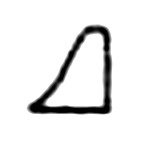



The poetic line: "At stenen var åndens tak" = "that the stone was the spirit's roof/ceiling". This obtains trivially by this being the uppermost part of the stone - along with the symmetric half on the other side of the hill-slope canal. It is the top of the head to the right.
19. Basket with handle
seems to be the round cheek of the righthand face - with handle in his nose or eyebrow. The line tells 'der hvor veienes rundhet svinger' = 'there where the ways (weighs?) roundness curves'.
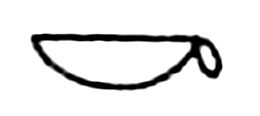

21. Loaf
The loaf is likely to mean just a 180 degrees turn of the basket with handle:

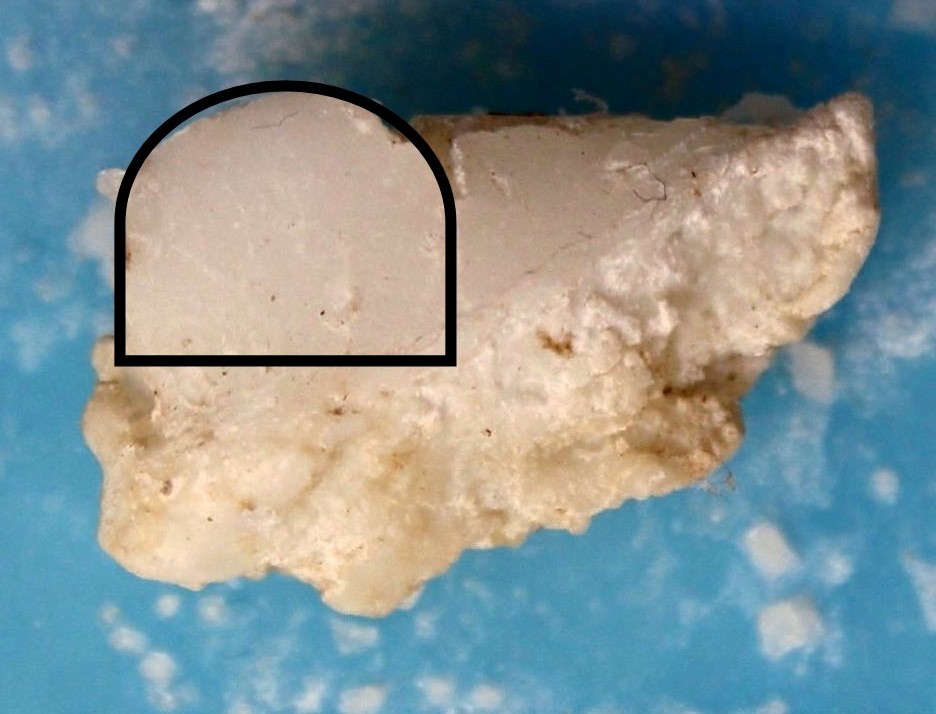


If turned 90 degrees it can mean the eyebrow of the man to the right, or clearly it could mean one of the curving heaps on top of the stone. The poetic line is very perfect for this glyph symbol: 'når nymånen engang blir full' = 'when the new moon once becomes full' - and this clearly could be telling of just 180 degrees turning from waxing to waning state. Or simply 90 degrees since the form is a loaf.
Summary remark on the hieroglyphs
The egyptian hieroglyphs can be seen to be that code which arises by emptying from the white philosophers stone the principled ambiguities relevant to language. The material discussed in this article adds weight to assumption that the form of the 64 poems reduced from the original 105 in my poetry book "Stillhetens åndedrag" is essential and not coincidental.
It can be added that the comparisons made in this article could constitute a quite notable discovery in the study of egyptian script: However, that depends on the degree to which the 'lapis philosophorum' I have arrived at counts as universal or unique. My impression is that the 'lapis philosophorum', being in the tradition of esoteric mysticism, could have come to suffice a degree of secrecy in administration sufficient for making it unavailable for the ordinary person. If so, it may be that the obervations I have made in this article could be quite standard in certain parts of administration - and if the unit of the centimetre has been defined in such a way that a standard 'lapis philosophorum' is just as long as Euler's constant, then one should expect that the observations made in the present article could be quite well known. But since I do not know to what extent the 'lapis philosophorum' which I made in 2014 is of a standard type, I cannot evaluate the degree to which these observations are matter known from earlier studies. See this article for some further comments.
Added on 11 december 2017: I have written also an article with a hypothesis on the nature of cuneiform that relates it to the nature of hieroglyphs.
© John Bjarne Grover
PS A few weeks after I had found the white stone in my kitchenbench, the news emerged that an alleged ESA spacecraft had managed to find a stone in a remote part of the sun system. Some of the photos from the stone could perhaps resemble my own stone a little. I was not involved in the spacecraft event.
On the web 24 november 2017
Last updated 11 december 2017